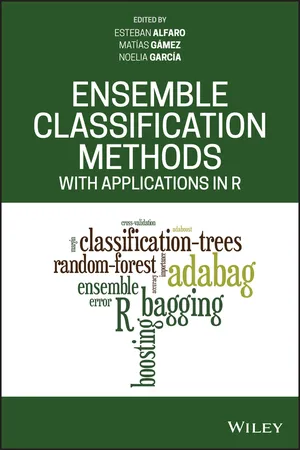
Ensemble Classification Methods with Applications in R
- English
- ePUB (mobile friendly)
- Available on iOS & Android
Ensemble Classification Methods with Applications in R
About This Book
An essential guide to two burgeoning topics in machine learning – classification trees and ensemble learning
Ensemble Classification Methods with Applications in R introduces the concepts and principles of ensemble classifiers methods and includes a review of the most commonly used techniques. This important resource shows how ensemble classification has become an extension of the individual classifiers. The text puts the emphasis on two areas of machine learning: classification trees and ensemble learning. The authors explore ensemble classification methods' basic characteristics and explain the types of problems that can emerge in its application.
Written by a team of noted experts in the field, the text is divided into two main sections. The first section outlines the theoretical underpinnings of the topic and the second section is designed to include examples of practical applications. The book contains a wealth of illustrative cases of business failure prediction, zoology, ecology and others. This vital guide:
- Offers an important text that has been tested both in the classroom and at tutorials at conferences
- Contains authoritative information written by leading experts in the field
- Presents a comprehensive text that can be applied to courses inmachine learning, data mining and artificial intelligence
- Combines in one volume two of the most intriguing topics in machine learning: ensemble learning and classification trees
Written for researchers from many fields such as biostatistics, economics, environment, zoology, as well as students of data mining and machine learning, Ensemble Classification Methods with Applications in R puts the focus on two topics in machine learning: classification trees and ensemble learning.
Frequently asked questions
Information
1
Introduction
1.1 Introduction
1.2 Definition
- Speed. Automatic procedures are usually quick and they can help to save time. For instance, automatic readers of postal codes are able to read most letters, leaving only some very complex cases to human experts.
- Objectivity. Important decisions have to be taken basing on objective criteria under the same conditions for all cases. Objectivity is sometimes difficult to ensure in the case of human deciders. In such cases, decisions can be affected from external factors, which would led us to take biased decisions.
- Explanatory capabilities. Some of the classification methods allow us not only to classify observations but to explain the reasons for the decision in terms of a set of statistical features.
- Economy. Having an expert who make decisions can be much mor...
Table of contents
- Cover
- Table of Contents
- List of Contributors
- List of Tables
- List of Figures
- Preface
- Chapter 1: Introduction
- Chapter 2: Limitation of the Individual Classifiers
- Chapter 3: Ensemble Classifiers Methods
- Chapter 4: Classification with Individual and Ensemble Trees in R
- Chapter 5: Bankruptcy Prediction Through Ensemble Trees
- Chapter 6: Experiments with Adabag in Biology Classification Tasks
- Chapter 7: Generalization Bounds for Ranking Algorithms
- Chapter 8: Classification and Regression Trees for Analyzing Irrigation Decisions
- Chapter 9: Boosted Rule Learner and its Properties
- Chapter 10: Credit Scoring with Individuals and Ensemble Trees
- Chapter 11: An Overview of Multiple Classifier Systems Based on Generalized Additive Models
- References
- Index
- End User License Agreement